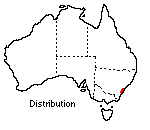Darwinia fascicularis
 |
 |
Darwinia fascicularis consists of two subspecies, both of which are useful plants for the rockery.
Darwinia fascicularis subsp. fascicularis occurs naturally from Gosford to Bulli in New South Wales within 30 km of the coast, growing in shallow soil at the edge of flat, exposed, sandstone ridges usually in dry sclerophyll scrub or in heathland below 500 m.
 It
forms a neat, compact, rounded shrub to 1 m x 1 m with light green, needle-like
leaves, crowded at the end of branches, opposite or whorled around the stem. The flowers are in clusters of from four to twenty nestled
in the foliage from early spring to late autumn. Individually they are small
and tubular with a protruding style.
The flowers open creamy-white and turn bright red with age.
It
forms a neat, compact, rounded shrub to 1 m x 1 m with light green, needle-like
leaves, crowded at the end of branches, opposite or whorled around the stem. The flowers are in clusters of from four to twenty nestled
in the foliage from early spring to late autumn. Individually they are small
and tubular with a protruding style.
The flowers open creamy-white and turn bright red with age.
Darwinia fascicularis subsp. fascicularis makes a useful cut flower.
Darwinia fascicularis subsp. oligantha occurs in the higher parts of the Blue Mountains from Mt Banks to Wentworth Falls, New South Wales where it grows on shallow soils on sandstone at about 600 m.
It forms a decumbent shrub rarely more than 50 cm high and spreads to 1 m in diameter. The branches will root readily when left in contact with the soil. The foliage is slightly less crowded and darker than the other subspecies. Flowers are generally in clusters of four to six, but the colour is similar to the other subspecies.
Both forms require good drainage, and if planted in an exposed site, mulching to achieve a cool root run is beneficial. A general fertiliser applied in late winter and autumn will improve flowering.
Both subspecies may be propagated by cuttings taken in early summer, but seed has been found to be difficult to germinate. It has been suggested that D. fascicularis subsp. fascicularis could be used as rootstock for less hardy West Australian species of Darwinia.
Both forms have proved to be frost hardy and will grow in full sun to heavy shade, however, lack of good drainage has caused losses in less favoured sites. Pests and diseases have not been noted as a problem except for occasional webbing moth caterpillar attacks. Minor occurences may be removed by hand. Consult a horticultural advisor for more major infestations.
Text by Stuart Donaldson , ANBG (1981)
Name meaning: Darwinia fascicularis:Darwinia - after Erasmus Darwin (1731-1802), physician, poet and botanist, and grandfather of Charles Darwin; fascicularis - from the Latin, fasciculus, meaning a little bundle, referring to leaves which are clustered at the ends of the branchlets; oligantha - from the Greek, oligo, few, and anthos, flower, referring to the small number of flowers in each inflorescence. |
![An Australian Government Initiative [logo]](/images/austgovt_brown_90px.gif)

